Applies to: Fix "Windows 10 will not shut down" error on Windows 10 2009/2004, Windows 10 1909/1903/1809/1803/1709, etc.
Is your computer stuck with this error: You clicked "Shut down", but Windows 10 refuse to shut down. And it automatically restarts instead of shutting down directly? Don't worry if your Windows 10 restarted after clicking "Shut down" from the Start menu.
Follow the navigation table and pick one of the fixes to resolve the "Windows 10 Won't Shut Down" error immediately:
| Workable Solutions | Step-by-step Troubleshooting |
|---|---|
| Fix 1. Disable Fast Startup | Open Power & sleep settings > Additional power settings > Choose what the power buttons do...Full steps |
| Fix 2. Run Full Shutdown | Run Command Prompt as administrator > Enter: shutdown /s /f /t 0...Full steps |
| Fix 3. Run Windows Troubleshooter | Type troubleshoot in search > Select "Troubleshoot". Under "Get up and running" section...Full steps |
| Fix 4. Enter Safe Mode, Cancel Automatically Restart | Boot PC to Safe Mode, open sysdm.cpl, uncheck "Automatically restart"...Full steps |
| For More Fixes | Boot PC from Safe Mode and change BIOS settings (in Fix 5 and 6)...Full steps |
For Your Information:
- If some of you are wondering why is Windows 10 or PC not shutting down, check out the causes first.
- For a detailed guide, follow the respective fixes to learn how to fix Windows 10 not shutting down issue.
- If you lost important files during the process, apply reliable data recovery software for help.
If you need manual Windows data recovery services, EaseUS's professional technical team is here to help you. They can help you solve any system startup errors, including system failure, BSOD, unbootable devices, and so on.
Consult with EaseUS data recovery experts for one-on-one manual recovery service. We could offer the following services after FREE diagnosis:
- Fix Windows boot issues, including BSOD
- Fix Windows error and configure Windows environment
- Restore the system when it fails to boot
- Optimize Windows computer to make it run quickly
Why Windows 11 or Windows 10 Won't Shut Down
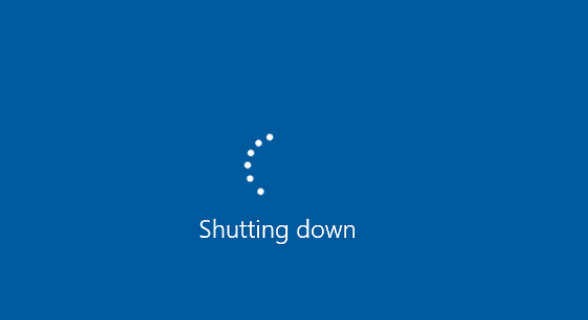
Why is my PC not shutting down? Why my Windows 10 won't shut down? Check the causes as listed below, you'll learn what is stopping your PC or Windows 10 from shutting down:
- Fast Startup is enabled.
- Corrupted system files
- Windows 10 update error
- BIOS issues
- Tip
- Fast Startup, also known as Hybrid Shutdown, is designed to reduce the start and shutdown time of PC. With Fast Startup enabled, your computer won't shut down fully.
- As a result, it may cause errors that will prevent your computer from shutting down.
So how do you fix "Windows was not properly shut down" and make Windows 10/8/7 work normally? Follow the methods in the next part for help.
How to Fix Windows 11/Windows 10 Not Shutting Down Error
Based on the underlying causes, there are several ways for you to fix the Windows 10 shutdown problem on your computer.
Quick Guide: Force to Shut Down Windows 10
The direct way to resolve Windows 10 not shutting down issue is to force your computer to shut down:
Step 1. Press and hold the power button on your computer until the PC turns off.
Step 2. Unplug all power cables (battery, power cord wires) for 5 to 10 minutes.
Step 3. Re-plug all the power cables and restart your computer.
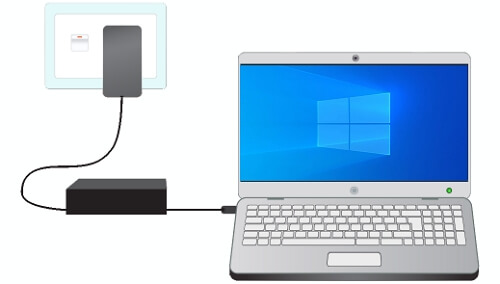
After entering your Windows PC, create a backup of your valuable files first. Then, you can try the below methods one by one to thoroughly resolve the "Windows 10 won't shut down" or "Windows 10 not shutting down" issue on your own.
Method 1. Disable Fast Startup
Turning off the Fast Startup feature is the quickest way to fix Windows 10 not shutting down.
Here are the steps to disable Fast Startup in Windows 10:
Step 1. Press Windows + X keys, click "Search" and type: power. Click "Power & sleep settings" from the search result.
Step 2. Scroll down the Settings window, click "Additional power settings".
Step 3. On the left pane of Power Options, click "Choose what the power buttons do".
Step 4. Click "Change settings that are currently available", then uncheck "Turn on fast startup (recommended)". Click "Save changes".
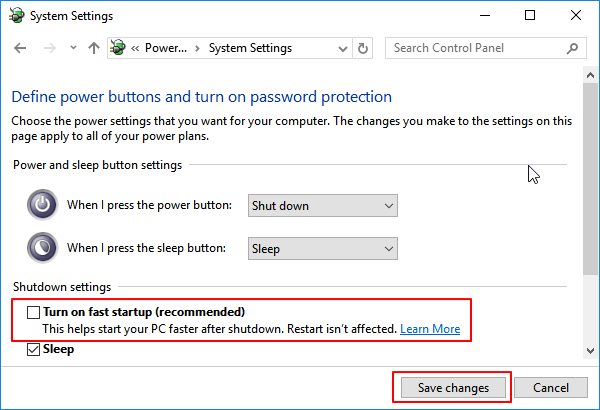
It's normal that the start and shutdown period in your computer increases after disabling Fast Startup. If you don't want to fix the Windows shutdown problem in this way, try other ways as shown below.
Method 2. Perform a Full Shutdown
The Fast Startup feature doesn't fully turn off your computer to decrease the booting time. Instead, it hibernates the kernel session, which is the reason why Windows 10 cannot shut down.
Thus, to fix the issue in this case, you have two options to perform a full shutdown on your computer in Windows 10/8/7:
Option 1. Use the Shift Key
Step 1. Click the Start menu and click the Power button.
Step 2. Click "Shut down" in the Start menu, press the "Shift" key simultaneously.

This will turn off your computer completely.
Option 2. Use CMD
Step 1. Press Windows + X keys, click "Search" and type cmd in the Search box.
Step 2. Right-click "Command Prompt" and choose "Run as administrator".
Step 3. Enter the command shutdown /s /f /t 0 and hit Enter.

Wait for the process to complete, your computer will shut down automatically.
Method 3. Run Windows Update Troubleshooter & Install the Latest Windows 10
Some users can't shut down Windows 10 during the update. If you are in such a situation, you can run the Windows troubleshooter to resolve problems that prevent you from updating Windows.
#1. Fix Errors That Stop Windows 10 from Shutting Down
Step 1. Right-click the Windows icon and select "Search", type troubleshoot in the Search box.
Step 2. In the result, choose "Troubleshoot".
Step 3. Under the "Get up and running" section, click "Windows Update".
Step 4. Click "Run the troubleshooter".
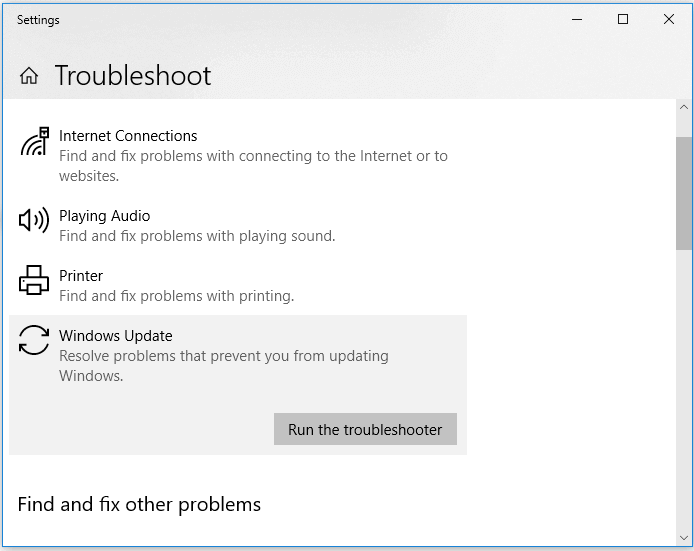
#2. Install The Latest Windows 11
Installing the latest Windows 11 on your computer can also work to fix some system errors or unknown bugs that stop your computer from shutting down. Also read: How to download and install Windows 11.
Method 4. Boot Computer from Safe Mode and Cancel Automatically Restart
When Windows 10 cannot shut down, it will keep restarting each time you press "Shut down" on your computer. Thus, another way to fix the issue is to disable automatic restart on your computer.
Step 1. Continuously press "F8" before the Windows logo appears.
Step 2. Release "F8" until the boot menu shows up and choose "Safe Mode".
Step 3. Boot the computer into Safe Mode and go to search after Windows boot-up.
Step 4. Type: sysdm.cpl and open sysdm.cpl.
Step 5. Click "Advanced" and "Settings" under Startup and Recovery.
Step 6. Uncheck "Automatically restart".
Step 7. Click "OK" and reboot the computer.
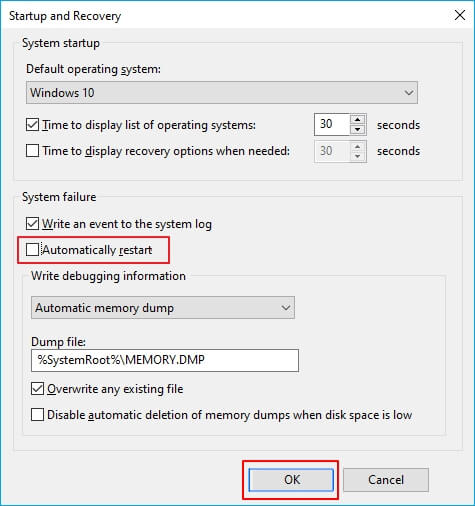
Afterward, shut down your PC and check whether the Windows 10 shutdown problem persists.
Method 5. Run Windows System File Checker Tool
If some of the Windows system files are corrupted on your computer, you will surely encounter problems, such as "a required drive partition is missing". The built-in Windows System File Checker is able to check and repair missing or corrupted system files for you.
It may help you fix the "Windows 10 won't shut down" issue, and here are the steps:
Step 1. Right-click the "Windows" icon, select "Search" and type cmd.
Step 2. Right-click "Command Prompt" and choose "Run as administrator".
Step 3. Enter the command sfc /scannow.
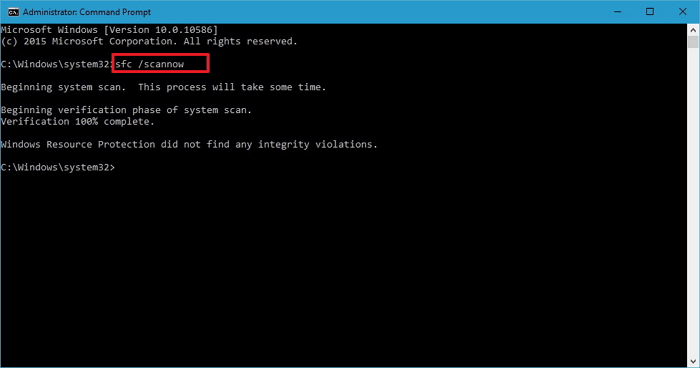
Step 4. When the process completes, shut down your PC.
Method 6. Change BIOS Settings
As mentioned, your Windows 10 may fail to shut down due to BIOS issues, be it wrong settings or corruption. You can first reset your BIOS to default.
Here are the steps:
Step 1. Force to shut down the computer by pressing the power button.
Step 2. Once your PC shuts down, restart the PC and press F2/F11/Del to enter BIOS.
Step 3. Go to the Boot section, select "The Default" or "HDD" at the top of the boot order.
Step 4. Press F10 or click "Save" to keep the changes, and exit BIOS.
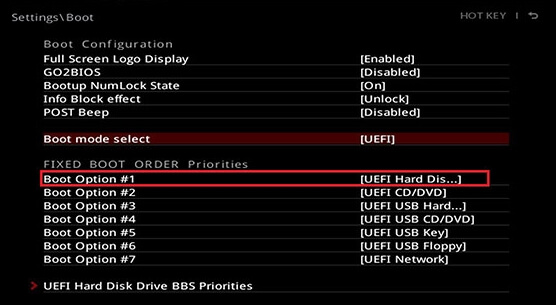
Step 5. Restart and shut down your PC.
After this, your computer will work normally again with a right start and shutdown state.
If none of the methods introduced helps to solve the problem "Windows 10 cannot shut down", you should consider getting your computer motherboard replaced.
Restore Lost Data While Fixing Windows Not Shutting Down
When the computer cannot shut down, it is often accompanied by data loss. If you lost files during or after fixing "Windows doesn't shut down", reliable EaseUS Data Recovery Wizard can help.
With this data recovery software, you can safely get your data back in only three steps:
Step 1. Run EaseUS Data Recovery Wizard on your computer. Choose the drive where you lost files and click "Search for Lost Data". If your lost files were on an external storage device, connect it to your computer firstly.

Step 2. The software will quickly scan the deleted files immediately, and then automatically perform a deep scan to find more lost files. After the scan is completed, you can use "Filter" or "Search box" to quickly locate specific file types.

Step 3. Click the "Preview" button or double-click on a file for a full preview. Finally, select the desired files, click "Recover" and choose another safe location or Cloud drive to save all the files at once.

This tool not only supports common deleted file recovery, formatted data recovery, and lost file recovery but also helps to recover data after OS crash, OS reinstallation, and more.
Bonus Fixes: Another Windows 10 Shutdown Error - PC Randomly Restart or Shutdown
"Windows 10 can't shut down" is just one of the Windows 10 shutdown problems. Another frequently happened issue is Windows randomly restart or shutdown. In case you need it, the solutions to this Windows 10 shutdown problem are:
Method 1. Change Power Options
This is an effectiveness-based solution to Windows randomly restarting or shutting down. Don't hesitate to try it if you are bothered by the Windows 10 shut down issue.
Step 1. Right-click the Windows icon, select "Search" and type power. From the search result, choose "Power & sleep settings".
Step 2. Go to Settings, scroll down and click "Additional power settings".
Step 3. Click "Change plan settings" > "Change advanced power settings"
Step 4. Expand "PCI Express" > "Link State Power Management".
Step 5. Set the "Settings" to "Off".
(If you are using a laptop, there are other options available. Set them to "Off", too.)
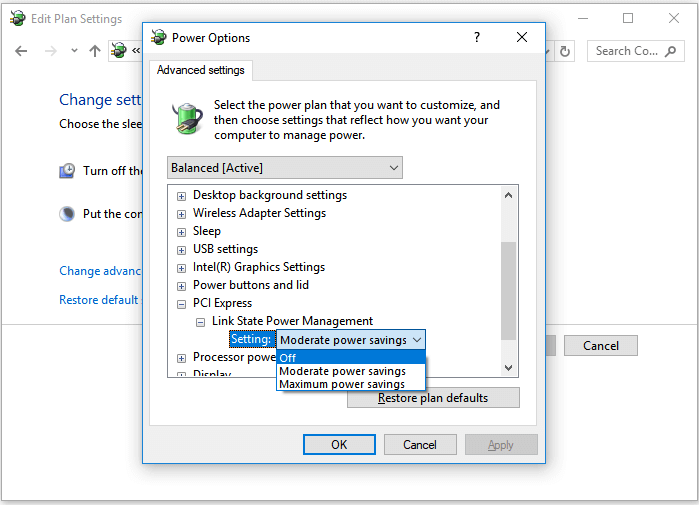
Method 2. Disable Hibernation
Disabling hibernation is quite easy with the help of cmd. Do as follows:
Step 1. Press Windows + X keys, click "Search" and type cmd in the box.
Step 2. Right-click "Command Prompt" and choose "Run as administrator".
Step 3. Enter powercfg.exe /hibernate off and hit Enter.

(This command is used to turn off hibernation on your computer. If you want to re-enable it, enter powercfg.exe /hibernate on instead.)
Step 4. Type exit to close command prompt when the process completes.
Hope at least one of the tips above is helpful to you to fix the Windows 10 shutdown problem.
FAQs About Windows 10 Won't or Not Shutting Down
In addition to the solutions for Windows not shutting down issue, some users may also want to learn the causes and what is slowing down the Windows shutdown process. Here we have the answers for you. Check and find the answer to your question now.
1. What to do when Windows won't shut down?
This page answers this question with 6+ solutions to help you get rid of Windows won't shut down issue.
You may try to: 1). Disable Fast Startup; 2). Run Full Shutdown; 3). Run Windows Troubleshooter; 4). Run System File Checker; 5). Boot from Safe Mode; 6). Change BIOS Settings.
Revert back to the main content on this page, and you can follow any method to make your computer shutdown normally again.
2. Why is my PC or laptop not shutting down?
The Hybrid Shutdown feature (also known as Fast Startup) released in Windows 8 and later is the primary reason why Windows doesn't shut down normally. It is enabled by default on most laptops and on some desktops.
The Faulty CMOS and BIOS settings can also cause Startup and Shutdown problems.
3. Why does Windows 10 take so long to shut down?
You may meet Windows takes forever or Windows fail to shut down issue when you forget to close all running programs and files on your computer.
The following issues may also slow down your Windows shutting down procedure:
- 1). Software Problems - If you have a lot of "Programs need to close", it takes time for the computer to close them one by one before shutting down.
- 2). Process Problems - Windows has to close all running processes before completely shutting down. The more processes are running on your computer, the slower it would be for the computer to shutdown.
- 3). Operating System or Driver Problems - When Windows OS or driver is outdated, the computer will slow down in starting up or shutting down.
- 4). Local Services Problems - When you have enabled many local services on your computer, it also takes time to close the services before Windows shutting down.
Was This Page Helpful?
Brithny is a technology enthusiast, aiming to make readers' tech lives easy and enjoyable. She loves exploring new technologies and writing technical how-to tips. In her spare time, she loves sharing things about her game experience on Facebook or Twitter.
Approved by Evan Galasso
Evan Galasso is a digital forensics and data recovery engineer with over 10 years of experience in the field. He presents opinions on the current state of storage media, reverse engineering of storage systems and firmware, and electro-mechanical systems of SSDs and HDDs.
Related Articles
-
SSD Lifespan: How Long Do SSDs Last
![author icon]() Brithny/Dec 12, 2025
Brithny/Dec 12, 2025 -
How to Recover Formatted Files with Free Format Recovery Software
![author icon]() Daisy/Dec 12, 2025
Daisy/Dec 12, 2025 -
MACHINE CHECK EXCEPTION Stop Code | Fixed
![author icon]() Dany/Dec 12, 2025
Dany/Dec 12, 2025 -
Does Formatting Laptop Make It Faster? Full Answers Here
![author icon]() Cedric/Dec 12, 2025
Cedric/Dec 12, 2025
